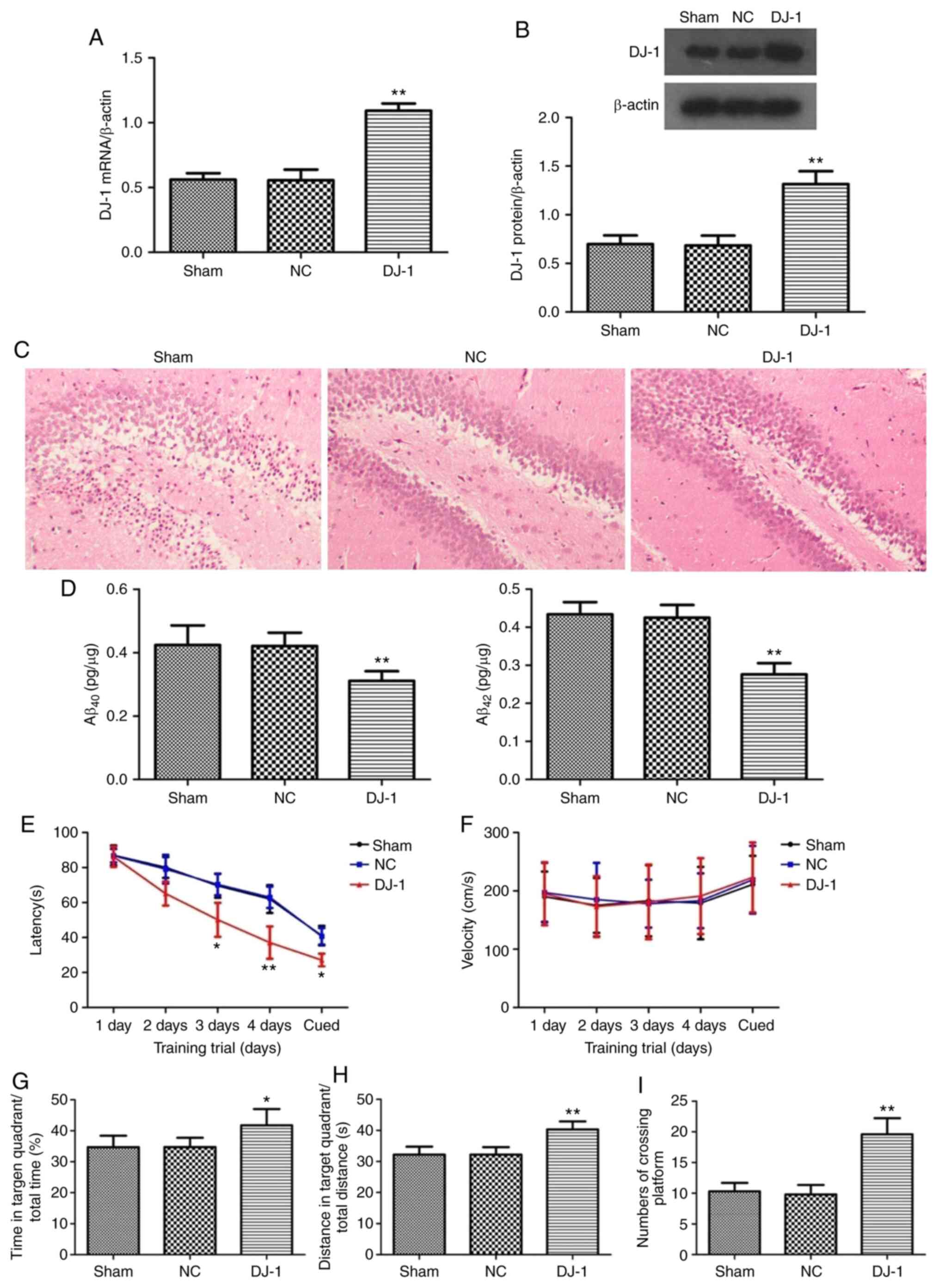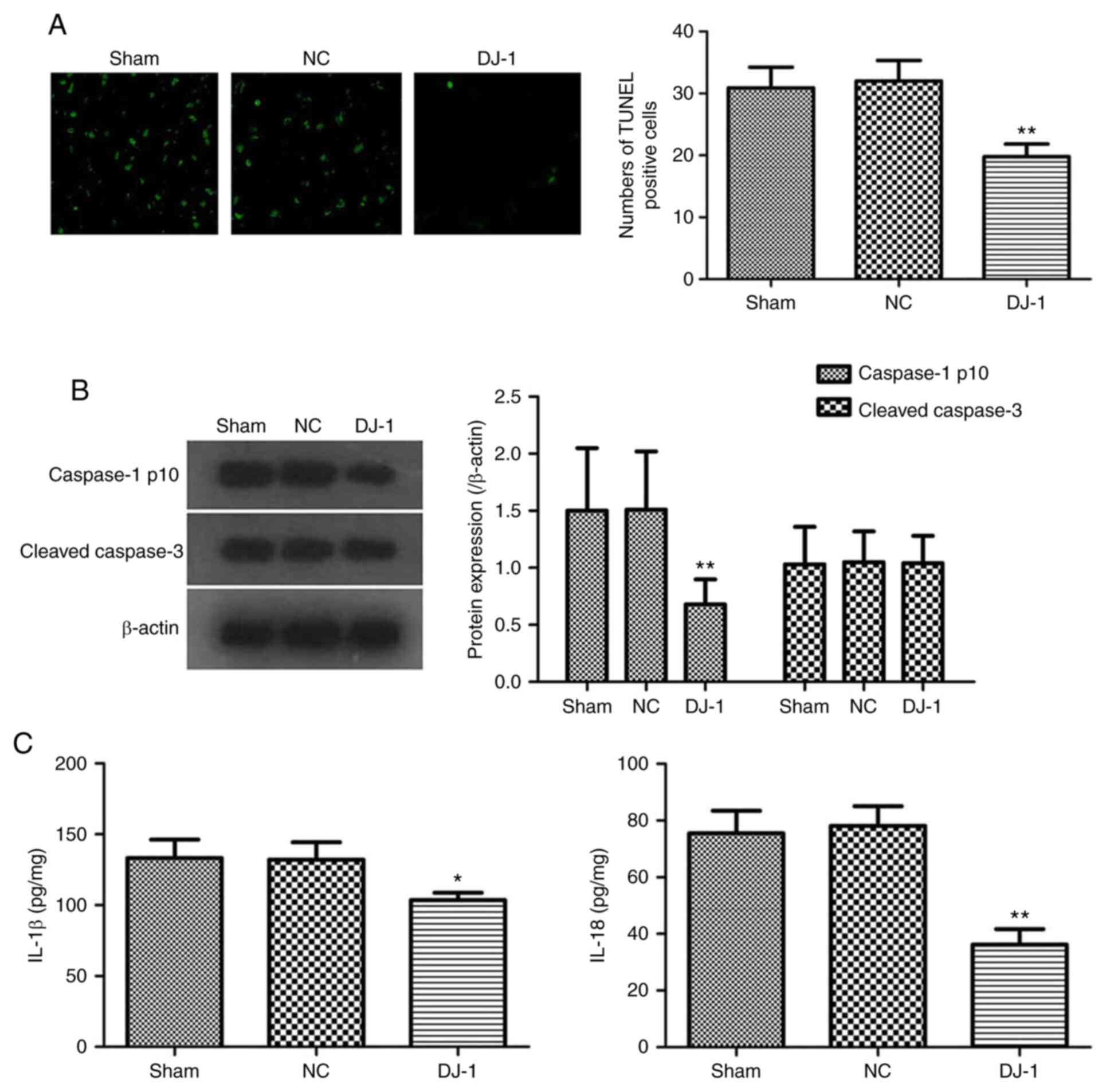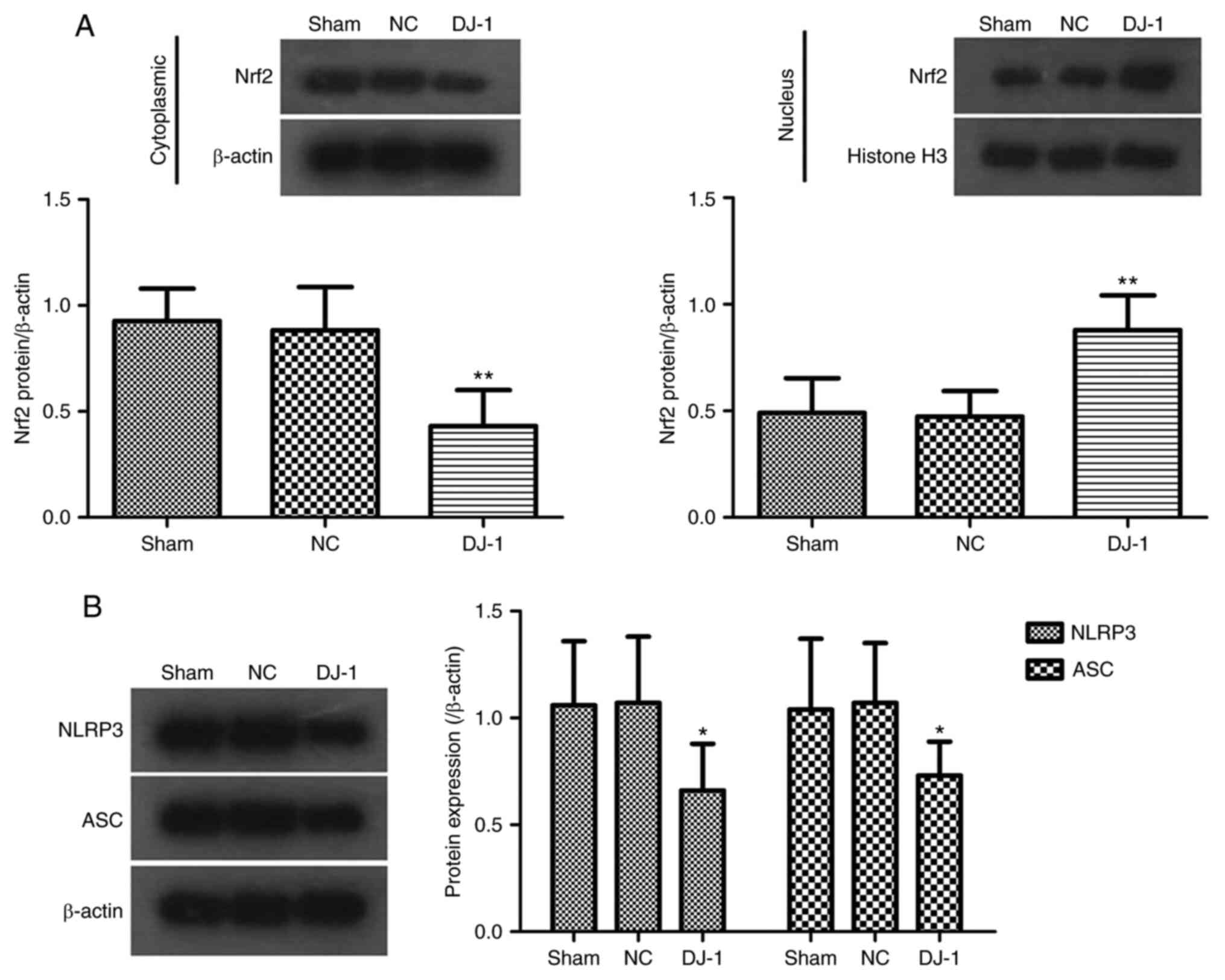|
1
|
Cummings J, Lee G, Mortsdorf T, Ritter A
and Zhong K: Alzheimer's disease drug development pipeline: 2017.
Alzheimer's Dement (N Y). 3:367–384. 2017.PubMed/NCBI View Article : Google Scholar
|
|
2
|
Graham WV, Bonito-Oliva A and Sakmar TP:
Update on Alzheimer's disease therapy and prevention strategies.
Annu Rev Med. 68:413–430. 2017.PubMed/NCBI View Article : Google Scholar
|
|
3
|
Polettini J, Richardson LS and Menon R:
Oxidative stress induces senescence and sterile inflammation in
murine amniotic cavity. Placenta. 63:26–31. 2018.PubMed/NCBI View Article : Google Scholar
|
|
4
|
Sankhla CS: Oxidative stress and
Parkinson's disease. Neurol India. 65:269–270. 2017.PubMed/NCBI View Article : Google Scholar
|
|
5
|
Collin F, Cheignon C and Hureau C:
Oxidative stress as a biomarker for Alzheimer's disease. Biomark
Med. 12:201–203. 2018.PubMed/NCBI View Article : Google Scholar
|
|
6
|
Tan MS, Tan L, Jiang T, Zhu XC, Wang HF,
Jia CD and Yu JT: Amyloid-Beta induces NLRP1-dependent neuronal
pyroptosis in models of Alzheimer's disease. Cell Death Dis.
2014(e1382)2018.PubMed/NCBI View Article : Google Scholar
|
|
7
|
Bergsbaken T, Fink SL and Cookson BT:
Pyroptosis: Host cell death and inflammation. Nat Rev Microbiol.
7:99–109. 2009.PubMed/NCBI View Article : Google Scholar
|
|
8
|
Hu Q, Zhang T, Yi L, Zhou X and Mi M:
Dihydromyricetin inhibits NLRP3 inflammasome-dependent pyroptosis
by activating the Nrf2 signaling pathway in vascular endothelial
cells. Biofactors. 44:123–136. 2018.PubMed/NCBI View Article : Google Scholar
|
|
9
|
Heo MJ, Kim TH, You JS, Blaya D,
Sancho-Bru P and Kim SG: Alcohol dysregulates miR-148a in
hepatocytes through FoxO1, facilitating pyroptosis via TXNIP
overexpression. Gut. 68:708–720. 2019.PubMed/NCBI View Article : Google Scholar
|
|
10
|
Zhao C, Gillette DD, Li X, Zhang Z and Wen
H: Nuclear factor E2-related factor-2 (Nrf2) is required for NLRP3
and AIM2 inflammasome activation. J Biol Chem. 289:17020–17029.
2014.PubMed/NCBI View Article : Google Scholar
|
|
11
|
Song L, Pei L, Yao S, Wu Y and Shang Y:
NLRP3 inflammasome in neurological diseases, from functions to
therapies. Front Cell Neurosci. 11(63)2017.PubMed/NCBI View Article : Google Scholar
|
|
12
|
Nagakubo D, Taira T, Kitaura H, Ikeda M,
Tamai K, Iguchi-Ariga SM and Ariga H: DJ-1, a novel oncogene which
transforms mouse NIH3T3 cells in cooperation with ras. Biochem
Biophys Res Commun. 231:509–513. 1997.PubMed/NCBI View Article : Google Scholar
|
|
13
|
McCoy MK and Cookson MR: DJ-1 regulation
of mitochondrial function and autophagy through oxidative stress.
Autophagy. 7:531–532. 2011.PubMed/NCBI View Article : Google Scholar
|
|
14
|
Xu J, Zhong N, Wang H, Elias JE, Kim CY,
Woldman I, Pifl C, Gygi SP, Geula C and Yankner BA: The Parkinson's
disease-associated DJ-1 protein is a transcriptional co-activator
that protects against neuronal apoptosis. Hum Mol Genet.
14:1231–1241. 2005.PubMed/NCBI View Article : Google Scholar
|
|
15
|
Gan L, Johnson DA and Johnson JA:
Keap1-Nrf2 activation in the presence and absence of DJ-1. Eur J
Neurosci. 31:967–977. 2010.PubMed/NCBI View Article : Google Scholar
|
|
16
|
Wu L, Xu H, Cao L, Li T, Li R, Feng Y,
Chen J and Ma J: Salidroside protects against mpp+-induced neuronal
injury through DJ-1-Nrf2 antioxidant pathway. Evid Based Complem
Alternat Med. 2017(5398542)2017.PubMed/NCBI View Article : Google Scholar
|
|
17
|
Sun Q, Shen ZY, Duan WN, Meng QT and Xia
ZY: Mechanism of myocardial ischemia/reperfusion-induced acute
kidney injury through DJ-1/Nrf2 pathway in diabetic rats. Exp Ther
Med. 14:4201–4207. 2017.PubMed/NCBI View Article : Google Scholar
|
|
18
|
Sun Q, Shen ZY, Meng QT, Liu HZ, Duan WN
and Xia ZY: The role of DJ-1/Nrf2 pathway in the pathogenesis of
diabetic nephropathy in rats. Ren Fail. 38:294–304. 2016.PubMed/NCBI View Article : Google Scholar
|
|
19
|
Lev N, Barhum Y, Ben-Zur T, Aharony I,
Trifonov L, Regev N, Melamed E, Gruzman A and Offen D: A DJ-1 based
peptide attenuates dopaminergic degeneration in mice models of
parkinson's disease via enhancing Nrf2. PLoS One.
10(e0127549)2015.PubMed/NCBI View Article : Google Scholar
|
|
20
|
Wang CY, Xu Y, Wang X, Guo C, Wang T and
Wang ZY: Dl-3-n-butylphthalide inhibits NLRP3 inflammasome and
mitigates Alzheimer's-Like pathology via Nrf2-TXNIP-TrX axis.
Antioxid Redox Signal. 30:1411–1431. 2019.PubMed/NCBI View Article : Google Scholar
|
|
21
|
Hou Y, Wang Y, He Q, Li L, Xie H, Zhao Y
and Zhao J: Nrf2 inhibits NLRP3 inflammasome activation through
regulating Trx1/TXNIP complex in cerebral ischemia reperfusion
injury. Behav Brain Res. 336:32–39. 2018.PubMed/NCBI View Article : Google Scholar
|
|
22
|
Wree A, Eguchi A, McGeough MD, Pena CA,
Johnson CD, Canbay A, Hoffman HM and Feldstein AE: NLRP3
inflammasome activation results in hepatocyte pyroptosis, liver
inflammation, and fibrosis in mice. Hepatology. 59:898–910.
2014.PubMed/NCBI View Article : Google Scholar
|
|
23
|
Bayne K: Revised guide for the care and
use of laboratory animals available. Physiologist. 39:208–211.
1996.PubMed/NCBI
|
|
24
|
Lamberty Y, Gower AJ, Gobert J, Hanin I
and Wulfert E: Behavioural, biochemical and histological effects of
AF64A following injection into the third ventricle of the mouse.
Behav Brain Res. 51:165–177. 1992.PubMed/NCBI View Article : Google Scholar
|
|
25
|
Ahmad J, Baig MA, Ali AA, Al-Huqail A,
Ibrahim MM and Qureshi MI: Comparative assessment of four RNA
extraction methods and modification to obtain high-quality RNA from
leaf. 3 Biotech. 7(373)2017.PubMed/NCBI View Article : Google Scholar
|
|
26
|
Livak KJ and Schmittgen TD: Analysis of
relative gene expression data using real-time quantitative PCR and
the 2(-Delta Delta C(T)) method. Methods. 25:402–408.
2001.PubMed/NCBI View Article : Google Scholar
|
|
27
|
Vorhees CV and Williams MT: Morris water
maze: Procedures for assessing spatial and related forms of
learning and memory. Nat Protoc. 1:848–858. 2006.PubMed/NCBI View Article : Google Scholar
|
|
28
|
Li HN, Jiang YM, Zhao P, Zhou S and Yu JQ:
Effects of oxymatrine on oxidative stress in brain tissue of
neonatal rats with hypoxic-ischemic brain damage. J Ningxia Med
Uni. 7:743–745. 2016.(In Chinese).
|
|
29
|
Lakshminarasimhan M, Maldonado MT, Zhou W,
Fink AL and Wilson MA: Structural impact of three
Parkinsonism-associated missense mutations on human DJ-1.
Biochemistry. 47:1381–1392. 2008.PubMed/NCBI View Article : Google Scholar
|
|
30
|
Joselin AP, Hewitt SJ, Callaghan SM, Kim
RH, Chung YH, Mak TW, Shen J, Slack RS and Park DS: ROS-dependent
regulation of parkin and DJ-1 localization during oxidative stress
in neurons. Hum Mol Genet. 21:4888–4903. 2012.PubMed/NCBI View Article : Google Scholar
|
|
31
|
D'Amelio M, Cavallucci V, Middei S,
Marchetti C, Pacioni S, Ferri A, Diamantini A, De Zio D, Carrara P,
Battistini L, et al: Caspase-3 triggers early synaptic dysfunction
in a mouse model of Alzheimer's disease. Nat Neurosci. 14:69–76.
2011.PubMed/NCBI View Article : Google Scholar
|
|
32
|
Miao EA, Rajan JV and Aderem A:
Caspase-1-induced pyroptotic cell death. Immunol Rev,. 243:206–14.
2011.PubMed/NCBI View Article : Google Scholar
|
|
33
|
Fink SL and Cookson BT:
Caspase-1-Dependent pore formation during pyroptosis leads to
osmotic lysis of infected host macrophages. Cell Microbiol.
8:1812–1825. 2006.PubMed/NCBI View Article : Google Scholar
|
|
34
|
Mota SI, Costa RO, Ferreira IL, Santana I,
Caldeira GL, Padovano C, Fonseca AC, Baldeiras I, Cunha C, Letra L,
et al: Oxidative stress involving changes in Nrf2 and ER stress in
early stages of Alzheimer's disease. Biochim Biophys Acta.
1852:1428–1441. 2015.PubMed/NCBI View Article : Google Scholar
|
|
35
|
Liu X, Zhang X, Ding Y, Zhou W, Tao L, Lu
P, Wang Y and Hu R: Nuclear factor E2-related factor-2 negatively
regulates NLRP3 inflammasome activity by inhibiting reactive oxygen
species-induced NLRP3 priming. Antioxidants Redox Signal. 26:28–43.
2017.PubMed/NCBI View Article : Google Scholar
|
|
36
|
Oakley H, Cole SL, Logan S, Maus E, Shao
P, Craft J, Guillozet-Bongaarts A, Ohno M, Disterhoft J, Van Eldik
L, et al: Intraneuronal beta-amyloid aggregates, neurodegeneration,
and neuron loss in transgenic mice with five familial Alzheimer's
disease mutations: Potential factors in amyloid plaque formation. J
Neurosci. 26:10129–10140. 2006.PubMed/NCBI View Article : Google Scholar
|
|
37
|
Liu WH, Shi LS, Chung MC, Chang TC and Lee
SY: Antcamphin M inhibits TLR4-mediated inflammatory responses by
upregulating the Nrf2/HO-1 pathway and suppressing the nlrp3
inflammasome pathway in macrophages. Am J Chin Med. 47:1611–1626.
2019.PubMed/NCBI View Article : Google Scholar
|
|
38
|
Lopez N, Tormo C, De Blas I, Llinares I
and Alom J: Oxidative stress in Alzheimer's disease and mild
cognitive impairment with high sensitivity and specificity. J
Alzheimers Dis. 33:823–829. 2013.PubMed/NCBI View Article : Google Scholar
|
|
39
|
Aliev G, Priyadarshini M, Reddy VP, Grieg
NH, Kaminsky Y, Cacabelos R, Ashraf GM, Jabir NR, Kamal MA,
Nikolenko VN, et al: Oxidative stress mediated mitochondrial and
vascular lesions as markers in the pathogenesis of Alzheimer
disease. Curr Med Chem. 21:2208–2217. 2014.PubMed/NCBI View Article : Google Scholar
|
|
40
|
Bonda DJ, Wang X, Perry G, Nunomura A,
Tabaton M, Zhu X and Smith MA: Oxidative stress in Alzheimer
disease: A possibility for prevention. Neuropharmacology.
59:290–294. 2010.PubMed/NCBI View Article : Google Scholar
|
|
41
|
Baulac S, Lu H, Strahle J, Yang T,
Goldberg MS, Shen J, Schlossmacher MG, Lemere CA, Lu Q and Xia W:
Increased DJ-1 expression under oxidative stress and in Alzheimer's
disease brains. Mol Neurodegener. 4(12)2009.PubMed/NCBI View Article : Google Scholar
|
|
42
|
Mullett SJ, Di Maio R, Greenamyre JT and
Hinkle DA: DJ-1 expression modulates astrocyte-mediated protection
against neuronal oxidative stress. J Mol Neurosci. 49:507–511.
2013.PubMed/NCBI View Article : Google Scholar
|
|
43
|
Zhang Z, Wang Q and Pu XP: Inhibition of
oxidative damage by high expression of wild-type DJ-1 gene in
SH-SY5Y cells cultured in vitro. Chin J New Drugs. 16:1854–1857.
2007.(In Chinese).
|
|
44
|
Kim RH, Smith PD, Aleyasin H, Hayley S,
Mount MP, Pownall S, Wakeham A, You-Ten AJ, Kalia SK, Horne P, et
al: Hypersensitivity of DJ-1-deficient mice to
1-methyl-4-phenyl-1,2,3,6-tetrahydropyrindine (MPTP) and oxidative
stress. Proc Natl Acad Sci USA. 102:5215–5220. 2005.PubMed/NCBI View Article : Google Scholar
|
|
45
|
Yagishita Y, Uruno A, Fukutomi T, Saito R,
Saigusa D, Pi J, Fukamizu A, Sugiyama F, Takahashi S and Yamamoto
M: Nrf2 improves leptin and insulin resistance provoked by
hypothalamic oxidative stress. Cell Rep. 18:2030–2044.
2017.PubMed/NCBI View Article : Google Scholar
|
|
46
|
Kaspar JW, Niture SK and Jaiswal AK:
Nrf2:INrf2 (Keap1) signaling in oxidative stress. Free Radic Biol
Med. 47:1304–1309. 2009.PubMed/NCBI View Article : Google Scholar
|
|
47
|
Nguyen T, Nioi P and Pickett CB: The
Nrf2-antioxidant response element signaling pathway and its
activation by oxidative stress. J Biol Chem. 284:13291–13295.
2009.PubMed/NCBI View Article : Google Scholar
|
|
48
|
Clements CM, McNally RS, Conti BJ, Mak TW
and Ting JP: DJ-1, a cancer- and Parkinson's disease-associated
protein, stabilizes the antioxidant transcriptional master
regulator Nrf2. Proc Natl Acad Sci USA. 103:15091–15096.
2006.PubMed/NCBI View Article : Google Scholar
|
|
49
|
Liu C, Chen Y, Kochevar IE and Jurkunas
UV: Decreased DJ-1 leads to impaired Nrf2-regulated antioxidant
defense and increased UV-A-induced apoptosis in corneal endothelial
cells. Invest Ophthalmol Vis Sci. 55:5551–5560. 2014.PubMed/NCBI View Article : Google Scholar
|
|
50
|
Zhang L, Zhang T and Tan N: Programmed
cell death independent of caspases. Pro Mod Biomed. 66:3760–3763.
2009.
|
|
51
|
Liu D, Zeng X, Li X, Mehta JL and Wang X:
Role of NLRP3 inflammasome in the pathogenesis of cardiovascular
diseases. Basic Res Cardiol. 113(5)2018.
|
|
52
|
Bossu P, Ciaramella A, Moro ML,
Bellincampi L, Bernardini S, Federici G, Trequattrini A, Macciardi
F, Spoletini I, Di Iulio F, et al: Interleukin 18 gene
polymorphisms predict risk and outcome of Alzheimer's disease. J
Neurol Neurosurg Psychiatry. 78:807–811. 2007.PubMed/NCBI View Article : Google Scholar
|
|
53
|
Ojala J, Alafuzoff I, Herukka SK, van
Groen T, Tanila H and Pirttila T: Expression of interleukin-18 is
increased in the brains of Alzheimer's disease patients. Neurobiol
Aging. 30:198–209. 2009.PubMed/NCBI View Article : Google Scholar
|
|
54
|
Feng J, Wang JX, Du YH, Liu Y, Zhang W,
Chen JF, Liu YJ, Zheng M, Wang KJ and He GQ: Dihydromyricetin
inhibits microglial activation and neuroinflammation by suppressing
NLRP3 inflammasome activation in APP/PS1 transgenic mice. CNS
Neurosci Ther. 24:1207–1218. 2018.PubMed/NCBI View Article : Google Scholar
|
|
55
|
Dempsey C, Rubio Araiz A, Bryson KJ,
Finucane O, Larkin C, Mills EL, Robertson AAB, Cooper MA, O'Neill
LAJ and Lynch MA: Inhibiting the NLRP3 inflammasome with MCC950
promotes non-phlogistic clearance of amyloid-β and cognitive
function in APP/PS1 mice. Brain Behav Immun. 61:306–316.
2017.PubMed/NCBI View Article : Google Scholar
|
|
56
|
Heneka MT, Kummer MP, Stutz A, Delekate A,
Schwartz S, Vieira-Saecker A, Griep A, Axt D, Remus A, Tzeng TC, et
al: NLRP3 is activated in Alzheimer's disease and contributes to
pathology in APP/PS1 mice. Nature. 493:674–678. 2013.PubMed/NCBI View Article : Google Scholar
|
|
57
|
Sokolovska A, Becker CE, Ip WK, Rathinam
VA, Brudner M, Paquette N, Tanne A, Vanaja SK, Moore KJ, Fitzgerald
KA, et al: Activation of caspase-1 by the NLRP3 inflammasome
regulates the NADPH oxidase NOX2 to control phagosome function. Nat
Immunol. 14:543–553. 2013.PubMed/NCBI View Article : Google Scholar
|
|
58
|
Choi AJ and Ryter SW: Inflammasomes:
Molecular regulation and implications for metabolic and cognitive
diseases. Mol Cells. 37:441–448. 2014.PubMed/NCBI View Article : Google Scholar
|
|
59
|
Lu L, Lu Q, Chen W, Li J, Li C and Zheng
Z: Vitamin D protects against diabetic retinopathy by inhibiting
high-glucose-induced activation of the ros/txnip/nlrp3 inflammasome
pathway. J Diabetes Res. 22(8193523)2018.PubMed/NCBI View Article : Google Scholar
|
|
60
|
Parajuli B, Sonobe Y, Horiuchi H, Takeuchi
H, Mizuno T and Suzumura A: Oligomeric amyloid β induces IL-1β
processing via production of ROS: Implication in Alzheimer's
disease. Cell Death Dis. 4(e975)2013.PubMed/NCBI View Article : Google Scholar
|
|
61
|
Wali JA, Gurzov EN, Fynch S, Elkerbout L,
Kay TW, Masters SL and Thomas HE: Activation of the NLRP3
inflammasome complex is not required for stress-induced death of
pancreatic islets. PLoS One. 9(e113128)2014.PubMed/NCBI View Article : Google Scholar
|
|
62
|
Liu X, et al: Nuclear Factor E2-Related
Factor-2 Negatively Regulates NLRP3 Inflammasome Activity by
Inhibiting Reactive Oxygen Species-Induced NLRP3 Priming.[J].
Antioxid Redox Signal. 26(28)2017.PubMed/NCBI View Article : Google Scholar
|


















